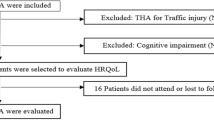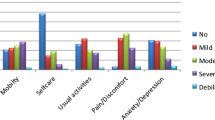Abstract
Purpose
The aim of the study was to evaluate quality of life (QOL), global health status, pain, and level of satisfaction in patients with hereditary multiple exostoses (HME), and to correlate the association between the severity of diseases and age, sex, number of surgical procedures, and number of exostoses.
Methods
The data of 50 patients with HME were retrospectively evaluated and recorded. QOL was evaluated with the Short-Form Health Survey (SF-12) questionnaire, the 12-Item General Health Questionnaire (GHQ-12), and Quality of Life Enjoyment and Satisfaction Questionnaire (Q-LES-Q-SF); intensity of pain was measured using the visual analogue scale (VAS). The association of age, gender, pain, quality of life, number of exostoses, and number of surgical procedures were evaluated and correlated.
Results
Mean number of exostoses in our patient’s cohort resulted 18.12 ± 8.60, and every patient underwent to a mean of 5.62 ± 5.74 surgical procedures for the exostoses. Mean VAS resulted 5.16 ± 2.90. Considering SF-12, mental (MCS) and physical (PCS) component resulted, respectively, 45.36 ± 10.76 and 38.73 ± 11.09, while GHQ-12 and Q-LES-Q-SF were 15.48 ± 4.70 and 45.28 ± 9.55, respectively. We found a significant positive correlation between the number of exostoses and the number of surgical procedures (p < 0.001), a significant positive correlation between the number of surgical procedures and GHQ-12 (p = 0.422) and VAS (p = 0.0011), and a negative correlation between the number of surgical procedures and PCS (p = 0.0257) and between age and GHQ-12 (p = 0.0385).
Conclusions
We can conclude that HME impact on patient quality of life as measured by the MCS and PCS scores similar to the disability associated with osteoarthritis in the mental component and tumors or diabetes as regards the physical component. Moreover, we found no difference in patients’ quality of life as regards number of exostoses, age, and surgical procedure, but we found that women have a worse response as regards the psychological side than men.
Similar content being viewed by others
References
Ryckx A, Somers JF, Allaert L (2013) Hereditary multiple exostosis. Acta Orthop Belg 79:597–607
Clement ND, Porter DE (2014) Hereditary multiple exostoses: anatomical distribution and burden of exostoses is dependent upon genotype and gender. Scott Med J 59:35–44
Singh P, Mukherjee SB (2015) Hereditary multiple exostoses, a tale of 50 years. Indian Pediatr 52:795–796
Martínez-Méndez JH, Gutiérrez-Acevedo M, Gómez-Cintrón ÁA, Mangual-García M, Sánchez-Cruz A, Trinidad-Hernández R, Santiago-Núñez M, Figueroa-Núñez C, Miranda-Adorno Mde L, Palermo-Garófalo C, Torres-Rafael O (2015) Multiple skeletal deformities in a middle-aged man. Puerto Rico Health Sci J 34:228–230
Czajka CM, DiCaprio MR (2015) What is the proportion of patients with multiple hereditary exostoses who undergo malignant degeneration? Clin Orthop Relat Res 473:2355–2361
D’Ambrosi R, Barbato A, Caldarini C, Biancardi E, Facchini RM (2016) Gradual ulnar lengthening in children with multiple exostoses and radial head dislocation: results at skeletal maturity. J Child Orthop 10:127–133
Sorel JC, Façee Schaeffer M, Homan AS, Scholtes VA, Kempen DH, Ham SJ (2016) Surgical hip dislocation according to Ganz for excision of osteochondromas in patients with multiple hereditary exostoses. Bone Joint J. 98:260–265
Mirpuri RG, Brammeier J, Chen H, Hsu FP, Chiu VK, Chang EY (2015) Spinal cord stimulation for treatment of the pain associated with hereditary multiple osteochondromas. J Pain Res 8:557–560
Driscoll M, Linton J, Sullivan E, Scott A (2013) Correction and recurrence of ankle valgus in skeletally immature patients with multiple hereditary exostoses. Foot Ankle Int 34:1267–1273
Goud AL, de Lange J, Scholtes VA, Bulstra SK, Ham SJ (2012) Pain, physical and social functioning, and quality of life in individuals with multiple hereditary exostoses in The Netherlands: a national cohort study. J Bone Joint Surg Am 94:1013–1020
Chhina H, Davis JC, Alvarez CM (2012) Health-related quality of life in people with hereditary multiple exostoses. J Pediatr Orthop 32:210–214
Piccinelli M, Bisoffi G, Bon MG, Cunico L, Tansella M (1993) Validity and test-retest reliability of the Italian version of the 12-item General Health Questionnaire in general practice: a comparison between three scoring methods. Compr Psychiatry 34:198–205
Ware J Jr, Kosinski M, Keller SD (1996) A 12-item Short-form health survey: construction of scales and preliminary tests of reliability and validity. Med Care 34:220–233
Wewers ME, Lowe NK (1990) A critical review of visual analogue scales in the measurement of clinical phenomena. Res Nurs Health 13:227–236
Endicott J, Nee J, Harrison W, Blumenthal R (1993) Quality of life enjoyment and satisfaction questionnaire: a new measure. Psychopharmacol Bull 29:321–326
Kodraliu G, Mosconi P, Groth N, Carmosino G, Perilli A, Gianicolo EA, Rossi C, Apolone G (2001) Subjective health status assessment: evaluation of the Italian version of the SF-12 health survey. Results from the MiOS project. J Epidemiol Biostat 6:305–316
Ferrara M, Meloni D, Caira D, Magherini F, Maglietta M, Baldasseroni A (2004) Common mental disorders in primary care: prevalence and determinants of a general health questionnaire as a screening tool. Epidemiol Prev 28:338–345
Wyrwich K, Harnam N, Revicki DA, Locklear JC, Svedsäter H, Endicott J (2009) Assessing health-related quality of life in generalized anxiety disorder using the quality of life enjoyment and satisfaction questionnaire. Int Clin Psychopharmacol 24:289–295
Author information
Authors and Affiliations
Corresponding author
Ethics declarations
Ethical approval
All procedures performed in studies involving human participants were in accordance with the ethical standards of the institutional and/or national research committee and with the 1964 Helsinki declaration and its later amendments or comparable ethical standards.
Conflict of interest
The authors declare that they have no conflict of interest.
Rights and permissions
About this article
Cite this article
D’Ambrosi, R., Ragone, V., Caldarini, C. et al. The impact of hereditary multiple exostoses on quality of life, satisfaction, global health status, and pain. Arch Orthop Trauma Surg 137, 209–215 (2017). https://doi.org/10.1007/s00402-016-2608-4
Received:
Published:
Issue Date:
DOI: https://doi.org/10.1007/s00402-016-2608-4




